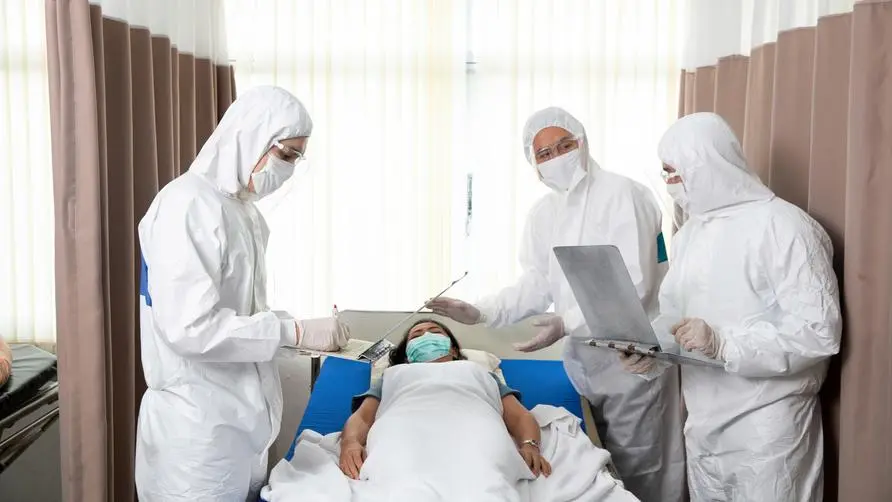Is a sudden "red rash" on your skin an allergy? He bought his own medicine to treat the ulcers on his lower body!

What is the reason for “little red spots” appearing on the body? Will buying your own medicine and applying it indiscriminately make your symptoms worse?
Why do “red granular spots” appear easily on the body? Dr. Luo Yang, a dermatologist at Neihu Cathay Clinic, said that blockage of sweat glands caused by sweating may indeed cause localized red spots, especially in people with hot and humid constitutions and poor perspiration function. In addition, men may experience “hair follicle inflammation” symptoms caused by exercise, friction between the perineum and underwear, or allergies and redness in the back of the scalp and hairline, which may also manifest as red dot symptoms.
Dr. Luo Yang shared that there was a college student in the clinic who bought steroids to apply on his own due to severe perineal allergies, which resulted in redness, swelling, and stinging in the area, and the condition worsened. After seeking medical treatment, he discovered that the problem was hair follicle inflammation. Doctors say that for hair follicle inflammation, you only need to keep the affected area ventilated. The doctor may also prescribe an ointment to target the inflammation. You should avoid buying external medicines to apply on your own, otherwise the erythema will not only not subside, but may also cause a more uncomfortable reaction.
Is a large area of "urticaria" a precursor to urticaria? Beware of shingles as it grows?
Many people think it is “eczema” when they see red spots on their skin. Dr. Luo Yang pointed out that eczema is a general term for symptoms of “slight inflammation of the skin.” Such as atopic dermatitis and seborrheic dermatitis, all fall into the category of eczema. It is different from the common symptoms of sweat rash and hair follicle inflammation.
In addition, there are also patients who develop a large erythema that suddenly occurs in various parts of the body, which is medically called “whetoma”. It may be a precursor to urticaria and is related to the patient’s own allergic constitution.
Dr. Luo Yang reminds that if the “rubella” begins to spread, such as from the abdomen to the waist, it may be a symptom of “herpes zoster”. Shingles is associated with low immunity and does not necessarily initially present as blisters. As long as herpes grows along the direction of the skin segments, you should pay attention. In the most severe cases, it may spread to all parts of the body.
Can exposure to strong sunlight cause allergies and rashes? Dr. Luo Yang explained that certain groups of people do have higher “ultraviolet sensitivity”. For example, patients with autoimmune diseases such as lupus erythematosus, whose skin is prone to redness, swelling and discomfort when exposed to direct sunlight. Patients with rosacea dermatitis are also more likely to be affected by light and heat sources, causing skin allergies.
Dr. Luo Yang reminds people that if they are exposed to strong light sources for too long, they may occasionally experience allergies and redness on the face, back of the neck, and neckline. In addition, after taking certain drugs, there will be “interactions” after the body’s metabolism, which may also trigger light allergy. If you find that your allergies are severe after exposure to the sun, you should seek medical attention as soon as possible.
Are red spots on the body a sign of cancer? Physician: There is usually no significant correlation between the two
Many rumors on the Internet indicate that the appearance of sticky red dots of varying sizes and distribution on the body is one of the precursors of “cancer” on the body. Is there a connection between cancer and the little red spots on the body? Dr. Luo Yang pointed out that if it refers to cancer of the skin itself, “primary” skin cancer can be roughly divided into three types:
Basal cell tumor. It appears as a single black nevus and can easily be confused with moles on the body.
Squamous cell tumor. The precursor may be “solar keratosis”, where the wound is irregular and prone to ulceration.
Melanoma. Black spots tend to appear on the extremities (such as fingers and toes).
The symptoms of skin cancer are not significantly related to the production of large-area erythema. However, if you are a cancer patient, such as liver cancer, lung cancer and other diseases, when malignant metastasis of cancer cells occurs in the body, the metastasis pattern is variable, and erythema may indeed be one of the symptoms.
Dr. Luo Yang reminded that young patients who have small red spots on their bodies are less likely to be related to cancer. If they have any concerns about skin surface symptoms, they should go to the dermatology or oncology department for further examination.
Further reading:





